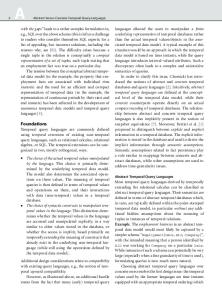Detection of Events In Multiple Streams of Surveillance Data
Simultaneous monitoring of multiple streams of data that carry corroborating evidence can be beneficial in many event detection applications. This chapter reviews analytic approaches that can be employed in such scenarios. We cover established statistical
- PDF / 729,152 Bytes
- 27 Pages / 439.37 x 666.142 pts Page_size
- 51 Downloads / 357 Views
CHAPTER OVERVIEW Simultaneous monitoring of multiple streams of data that carry corroborating evidence can be beneficial in many event detection applications. This chapter reviews analytic approaches that can be employed in such scenarios. We cover established statistical algorithms of multivariate time series baseline estimation and forecasting. They are relevant when multiple streams of data can be modeled jointly. We then present more recent methods which do not have to rely on such an assumption. We separately address techniques that deal with data in a specific form of a record of transactions annotated with multiple descriptors, often encountered in the practice of health surveillance. Future event detection algorithms will benefit from incorporation of machine learning methodology. This will enable adaptability, utilization of human feedback, and building reliable detectors using some examples of events of interest. That will lead to highly scalable and economical multi-stream event detection systems. Keywords: Event detection; Analysis of multivariate time series; Health surveillance
*
Auton Lab, Carnegie Mellon University, Newell Simon Hall 3128, 5000 Forbes Ave, Pittsburgh PA 15213-3815, USA
D. Zeng et al. (eds.), Infectious Disease Informatics and Biosurveillance, Integrated Series in Information Systems 27, DOI 10.1007/978-1-4419-6892-0_7, © Springer Science+Business Media, LLC 2011
145
146
1.
Chapter 7
INTRODUCTION
Simultaneous monitoring of signals coming from distinct sources, or surveying diverse aspects of data even if it comes from a single source, can yield improvements in accuracy, sensitivity, specificity and timeliness of event detection over more traditional univariate analyses. Suppose for instance that today’s sales of cough and cold medications are insignificantly higher than normal, absenteeism among school children in the district is up by one and a half standard deviation estimated from normal historical data, and a slightly higher than usual number of respiratory patients report to the region’s emergency rooms. None of these individual signals are substantial enough to cause an alert on their own, but when looked at in conjunction, they may raise concern. Or suppose that in monitoring sales of non-prescription medicines, a particular region reports an unexpected increase in sales of pain relief and anti-fever drugs. However, it appears to be aligned with an unexpected rise of sales of non-medication groceries. This may indicate that the population of the region has increased (e.g., due to a sunny winter weekend in a mountain town). That in turn may sufficiently explain the initial observation about pain killers and dismiss the concern of a possible outbreak of infectious disease based on the single-stream analysis. Or, suppose that among the chief complaints of two cases from two different hospitals in the same city on the same date there was mention of bloody stools in pediatric patients. The multiple mentions of “bloody stools” or “pediatric” is not a surprise but the tying
Data Loading...











